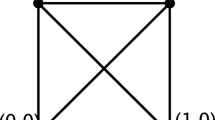Abstract
The size of the smallest stopping set in a low-density parity check (LDPC) code determines, to an extent, the performance of iterative decoding methods over the binary erasure channel. In an LDPC code arising from a block design, a stopping set is a subset of its blocks with the property that every point belonging to one of the selected blocks belongs to at least two of them. While some Steiner triple systems have no stopping sets of size 5 or less, it is shown that every Steiner triple system has a stopping set of size at most 7. The proof can be viewed as an application of polynomial identities among configuration counts that generalize the family of known linear identities. While no example of a Steiner triple system whose smallest stopping set has size seven is known, it is shown that a partial Steiner triple system on v points with c·v 1.8 triples that has no stopping set of size less than 7 exists.



Similar content being viewed by others
References
Colbourn, C.J.: Triple systems. In: Colbourn, C.J., Dinitz, J.H. (eds.) Handbook of Combinatorial Designs, 2nd edn., pp. 58–72. CRC/Chapman and Hall, Boca Raton (2007)
Colbourn, C.J.: The configuration polytope of ℓ-line configurations in Steiner triple systems. Math. Slovaca (2008, in press)
Colbourn, C.J., Mendelsohn, E., Rosa, A., Širáň, J.: Anti-mitre Steiner triple systems. Graphs Comb. 10, 215–224 (1994)
Colbourn, C.J., Rosa, A.: Triple Systems. Oxford University Press, Oxford (1999)
Colbourn, M.J., Colbourn, C.J., Rosenbaum, W.L.: Trains: an invariant for Steiner triple systems. Ars Comb. 13, 149–162 (1982)
Danziger, P., Mendelsohn, E., Grannell, M.J., Griggs, T.S.: Five-line configurations in Steiner triple systems. Util. Math. 49, 153–159 (1996)
Di, C., Proietti, D., Richardson, T., Telatar, E., Urbanke, R.: Finite length analysis of low-density parity-check codes on the binary erasure channel. IEEE Trans. Inf. Theory 48, 1570–1579 (2001)
Erdős, P.: Problems and results in combinatorial analysis. Creat. Math. 9, 25 (1976)
Forbes, A.D., Grannell, M.J., Griggs, T.S.: Configurations and trades in Steiner triple systems. Australas. J. Comb. 29, 75–84 (2004)
Forbes, A.D., Grannell, M.J., Griggs, T.S.: On 6-sparse Steiner triple systems. J. Comb. Theory (A) 114, 235–252 (2007)
Fujiwara, Y.: Constructions for anti-mitre Steiner triple systems. J. Comb. Des. 13, 286–291 (2005)
Fujiwara, Y.: Infinite classes of anti-mitre and 5-sparse Steiner triple systems. J. Comb. Des. 14, 237–250 (2006)
Fujiwara, Y., Colbourn, C.J.: A Combinatorial Approach to X-Tolerant Compaction Circuits. (2007, in press)
Grannell, M.J., Griggs, T.S., Mendelsohn, E.: A small basis for four-line configurations in Steiner triple systems. J. Comb. Des. 3, 51–59 (1994)
Grannell, M.J., Griggs, T.S., Whitehead, C.A.: The resolution of the anti-Pasch conjecture. J. Comb. Des. 8, 300–309 (2000)
Horáak, P., Phillips, N., Wallis, W.D., Yucas, J.: Counting frequencies of configurations in Steiner triple systems. Ars Comb. 46, 65–75 (1997)
Kashyap, N., Vardy, A.: Stopping sets in codes from designs. In Proc. IEEE Intl. Symp. Inform. Theory (ISIT), p. 122. IEEE, Yokohama (2003)
Kim, S., No, J.S., Chung, H., Shinj, D.J.: Quasi-cyclic low-density parity-check codes with girth larger than 12. IEEE Trans. Inf. Theory 53(8), 2885–2891 (2007)
Kou, Y., Lin, S., Fossorier, M.: Low density parity check codes based on finite geometries: a rediscovery and new results. IEEE Trans. Inf. Theory 47, 2711–2736 (2001)
Laendner, S., Milenkovic, O.: Codes based on latin squares: stopping set, trapping set, and cycle-length distribution analysis. IEEE Trans. Commun. 55, 303–312 (2007)
Lazebnik, F., Verstraëte, J.: On hypergraphs of girth five. Electron. J. Comb. 10 Research Paper 25, 15 (electronic) (2003)
Ling, A.C.H., Colbourn, C.J., Grannell, M.J., Griggs, T.S.: Construction techniques for anti-Pasch Steiner triple systems. J. Lond. Math. Soc. 61(2), 641–657 (2000)
Orlitsky, A., Viswanathan, K., Zhang, J.: Stopping set distribution of LDPC code ensembles. IEEE Trans. Inf. Theory 51(3), 929–953 (2005)
Ruzsa, I., Szemerédi, E.: Triple systems with no six points carrying three triangles. Combinatorics (Proc. Fifth Hungarian Colloq., Keszthely, 1976), vol. II, pp. 939–945. Colloq. Math. Soc. János Bolyai, 18. North-Holland, Amsterdam (1978)
Stinson, D.R.: A comparison of two invariants for Steiner triple systems: fragments and trains. Ars Comb. 16, 69–76 (1983)
White, H.S.: Triple-systems as transformations, and their paths among triads. Trans. Am. Math. Soc. 14, 6–13 (1913)
Wolfe, A.: The resolution of the anti-mitre Steiner triple system conjecture. J. Comb. Des. 14, 229–236 (2006)
Xia, S.-T., Fu, F.-W.: On the stopping distance of finite geometry LDPC codes. IEEE Commun. Lett. 10(5), 381–383 (2006)
Author information
Authors and Affiliations
Corresponding author
Rights and permissions
About this article
Cite this article
Colbourn, C.J., Fujiwara, Y. Small stopping sets in Steiner triple systems. Cryptogr. Commun. 1, 31–46 (2009). https://doi.org/10.1007/s12095-008-0002-y
Received:
Accepted:
Published:
Issue Date:
DOI: https://doi.org/10.1007/s12095-008-0002-y




